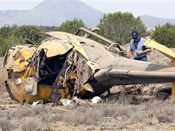Necessity of EMS Helicopter Transports
Are all EMS helicopter transports necessary?
Undeniably, there are situations where emergency medical services (EMS) require helicopter transport to get a patient to a hospital quickly. Sometimes it is because of the terrain, such as an accident or injury on the side of a mountain. Sometimes it is because of the severity of the injury including major head and internal injuries after a highway accident. Sometimes it is simply a matter of distance, where ground transportation would take too long to reach the nearest hospital.
However there are many cases when EMS helicopters are not required. One independent study of patients transported to hospital by helicopter found that most patients – at least two-thirds – were being transported with non-life-threatening injuries. In fact a relatively large number of patients flown (10%) had injuries that did not even require hospitalization.
Given the identified risks of air ambulance flights (not to mention the added expense), are these transports necessary? The authors of the study seem to think not, and called for a better method of assessing patients on the ground to identify if their injuries require the speed and risk of EMS helicopter transport. This, the authors say, will avoid “helicopter overutilization”.
Helicopter Overutilization a Growing Problem
In the 1970s and 80s, there were studies that suggested patients had a better chance of recovery if transported to hospital by helicopter. Many hospitals acted on this information by creating their own air ambulance programs.
But then two things happened. First, hospitals began cutting back expenses by closing their own programs and subcontracting EMS helicopter services to private companies. Second, the EMS helicopter industry successfully lobbied government to raise Medicare reimbursements for helicopter transports. Suddenly this became a very lucrative business with a high demand for private operating companies to take over services.
Soon helicopters were being dispatched instead of ground ambulances for no apparent reason – except that the private EMS operators would be able to bill higher. Nobody ever seriously challenged the practice, even as transportation costs rose, and as accident rates for air ambulances approached those of military helicopters in combat. Generally it was assumed that helicopter transport was the fastest and safest method of transporting patients.
Today, there are 750 to 800 air ambulances flying the skies. They are given special permission to fly into bad weather and night conditions, they “heroically” attempt dangerous maneuvers that increase safety risks for crew and patients, and, perhaps worst of all, the industry as a whole is one of the least-regulated in U.S. aviation.
This and a whole list of other factors are adding up to disastrous results. From 2000 to July 2005, there were 84 EMS helicopter crashes killing 60 people. According to those numbers, between 10% and 15% of all EMS helicopters nationwide crashed in less than five years.
Now we are at a point where studies are showing that in almost all cases, there are no medical benefits to transporting patients by helicopter rather than by ground ambulance. Yet crash statistics continue to climb. If passengers knew that the EMS helicopter transporting them had a 1 in 10 chance of crashing in the next five years, how many would choose ground transport instead?
Find Out More About Your Case
If you or a loved one has been injured during an EMS helicopter flight, contact David P. Willis to find out your legal options. We will give you a free and comprehensive case review, let you know what your rights are, and if necessary, help you fight to get the compensation you deserve. Call us Toll-Free right now to start your free assessment, or email us for more information.
Contact a Helicopter Lawyer
If you have been injured or a loved one has been killed in a helicopter crash, then call us 24/7 for an immediate consultation to discuss the details of the accident and learn what we can do to help protect your legal rights. Whether the accident was caused by negligence on the part of the helicopter owner, hospital or corporation, the manufacturer or due to lack of training, poor maintenance, pilot or operator error, tail rotor failure, sudden loss of power, defective electronics or engine failure or flying in bad weather conditions, we can investigate the case and provide you the answers you need. Call Toll Free 1-800-883-9858 and talk to a Board Certified Trial Lawyer with over 30 years of legal experience or fill out our online form by clicking below:


